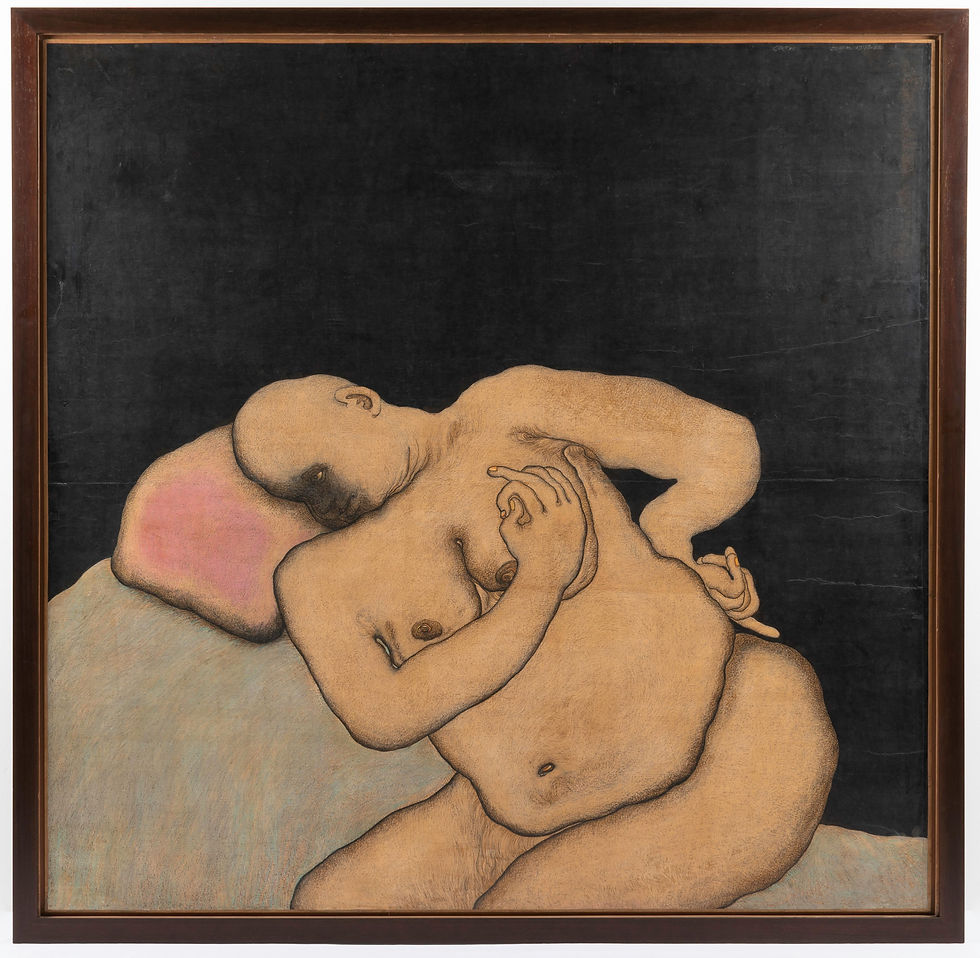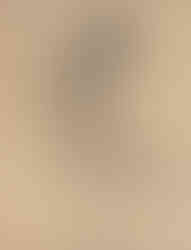The Art of Eloquent Lines: Jogen Chowdhury
- Ranjan Kaul
- Mar 22, 2023
- 7 min read
by Ranjan Kaul
Jogen Chowdhury’s retrospective exhibition titled "Into the Half Light and Shadow Go I" organized by Art Exposure Gallery, Kolkata, at Bikaner House, New Delhi, has given viewers in the capital a splendid opportunity to get an insight into the journey of the artist over several decades. The exhibition is testimony to his continuous search for a distinctive visual language that is uniquely his own and which allows free rein to his emotive power to capture the complexities of the human condition. The show presents a comprehensive range of subject matter and the various mediums he employs, particularly the unbroken lines that speak, with use of cross-hatching in pen and ink and shades of dry pastel or watercolour.

With Jogen Chowdhury
I had the privilege to engage with Jogen Chowdhury in a free-flowing conversation at the exhibition venue. He was born on 16 February 1939 in an East Bengal village of Dharapara, Faridpur, now in Bangladesh. When he was barely nine, he and his family were compelled to shift in with his uncle in Calcutta and then later to a refugee colony in Dhakuria. He joined the Government College of Art and Crafts, Kolkata, and got involved with many cultural and professional activities. As an art student he would copy masters such as Picasso and Abanindranath Tagore and would visit Sealdah station to sketch refugees. He would also accompany Sunil Das to stables to draw horses. In addition, he did flower studies and portraits. His self-portraits are introspective, enquiring and incisive at the same time – an honest encounter with the self.

Clockwise from top: Reclining Woman, Ink and pastel on paper, 46.5 x 67.5 cm, 1960, Dhakuria, Calcutta; A Refugee Child, Dry pastel on paper, 41.5 cm x 35.5 cm, 1989, Howrah station, Calcutta;
Face of a Refugee Girl, Dry pastel on paper, 43 x 30 cm, Sealdah, Calcuta, 1960
Left: Old Man, Black ink and brush on paper, 25.5 x 18.7 cm, 1992
Right: Old Man with Beard, Black ink and brush on paper, 25.5 x 18.7 cm, 1992

Left: Banana Flower, Ink with brush on paper, 28 cm x 19.5 cm, 1992, Santiniketan;
Right: Flower, Ink and wash on paper, 25.5 cm x 18.6 cm, 1992
(Photos by Ranjan Kaul)
Early self-portraits on display at the exhibition (Photos by Ranjan Kaul)

Untitled, Oil on canvas, 1966, Paris
However, it was his tenure in Paris after his graduation on a French Government Scholarship where he also enrolled at William Hayter's Atelier 17 and joined L’Ecole National Supérieure des Beaux Arts, Paris, , he says, that was a turning point in his journey. His stay in Paris, where he watched films and was exposed to diverse works of modern art, helped him realize the criticality of developing a distinctive vision of his own. His Untitled work of the distorted figure of a man (see above) gives an inkling of the path he would later adopt as his distinctive style. On his return to India, after brief interludes in Chennai and Calcutta, he joined Rashtrapati Bhavan as the Art Keeper of the collection and subsequently went to Kala Bhavana in Santiniketan, West Bengal, as an art teacher. Jogen shares,
“Post-1980 I started thinking anew about the shape of the human figure . . . my humans convey a trait, a gesture, there is always some drama. Now, I was rivetted by Indian figures, their shapes and attributes, their essence, the facial expressions – standing in repose or lying down. This added a new dimension to my art.”
While through his academic training and rigorous practice (of which there is ample evidence in the numerous sketchbooks on display at the show) he had acquired the necessary skills, it was the childhood memories of socio-cultural and political events of the 1940s in Bengal that affected his sensibilities and had a lasting influence on his art. The memories of the Bengal Famine starting 1943, the Calutta Riots of 1946, the Partition, and the Left movement permeated his art in a defining way as his oeuvre steadily evolved and matured from his formative years as an artist.
I ask Jogen about the influence on his work of artists such as Chittoprasad Bhattacharya and Somnath Hore who were closely involved with the communist movement. He says that while he was aware of their work and shared their commitment to human values, he never did feel inclined to join the movement. From the beginning he was determined to tread an independent path in pursuit of a unique personal artistic vision. No particular artist, he says, has had a major impact on his art. Rather, he seems to have drawn from Bengal’s folk art, the Kalighat pat and alpona traditions, as he developed his transcultural oeuvre of rendering figures with the free fluidity of unbroken lines. Indeed, it is with the Bengal cultural ethos represented in literature and films with poets like Jibananada Das and film-makers such as Ritwik Ghatak and Satyajit Ray that we find parallels in Jogen's art. When I ask him whether he ever contemplated developing a typically Indian art idiom, his unequivocal response is that good art irrespective of where you make it has universal appeal and will find appreciation across cultures.
The curators of the show, Jesel Thacker and Soumik Nandy Majumdar, view Jogen’s art through the lens of contemporary literature and poetry. The title "Into the Half Light and Shadow Go I" is the opening line from the Bodh (sensation) which functions as a gateway to the curatorial framework of the show. The curatorial idea attempts at tracing how the artist has encountered the signs of human angst from his early works, including the academic exercises which anticipate his human concerns vis-à-vis social reality.
While the cadence and flow of Jogen’s art stems from an affinity with animals and nature, it is the suffering, plight and psyche of humans that foregrounds all his work. The figure is the mainstay of his art, represented in thick fluidic lines and expressive distortion; he conveys all he has to say through conscious simplification using the line, with the use of pastel shades and cross-hatching to merely provide the needed volume.
In Those Unknown Faces, it is the mood of the three women that assumes significance against the black background. Exuding an effusive sensuality, the women sit close to each other, conveying a sense of both isolation and togetherness. Distortion is a device that he employs to express the human condition; for example, in the twisted face and figure in Dreaming, there is a strong satirical element and at the same time a sense of optimism expressed through the eyes that look in different directions. Even when he paints plants and animals, the stylized distortion often remains, reflective of human sentience (see Horse). We see a similar contorted rendition of the female human body in his works done as recently as 2022 (see below), with the expression a mix of perplexity, anxiety or in pain.

Those Unknown Faces, Pen and ink and pastels on paper, 40 x 60 in.

Dreaming, Pen, Ink with pastels on paper, 2009


Horse, Pen and ink with pastels, 25 and 35 cm, 2022

Left: Banana Flower, Ink with brush on paper, 28 cm x 19.5 cm, 1992, Santiniketan
Right: Flower, Ink and wash on paper, 25.5 cm x 18.6 cm, 1992
Jogen’s more recent series, Age of Tooth and Nail (2020), is a symbolic manifestation of the climate we are living in, where the artist leaves it to the viewer to interpret who the attacker is and who the victim. The series is reminiscent of his earlier Bakasur series (2009). (Bakasur is the crane asura in Indian mythology who was killed by Krishna.) Although Jogen’s practice is grounded in his search for a modern and yet enduring visual language, he is cognizant of the social and political environment of the times he lives in. As he says,
“Time and space are the main driving forces that compel me to continue my work as an artist. Circumstances and specific events influence our perception of life at any given point in time. The fact that the situations alter, time is found in flux and one’s position vis-à-vis the social environments is also subject to change, keeps the artist in me on my toes, directing all my attention towards creating art.”

Left and right top: Age of Tooth and Nail, Pen and ink with dry pastels, 10 x 10 in., 2020, each
Right bottom: Bakasur-II, Ink on paper, 69.5 cm x 50 cm, 2009, Santiniketan
Left: Untitled, Ink, pen and pastels on paper, 18.5 cm x 23.7 cm, 2009, Santiniketan
Right: Untitled, Ink, pen and pastels on paper, 18.5 cm x 23.6 cm, 2009, Santiniketan
As we sit talking at the entrance of the exhibition venue, two intriguing untitled works of quilts (see above) draw my attention. Done in pen, ink and pastel hints of red, meanings emerge as we discuss them – the social fabric being ruptured, the dabs of reds symbolic of blood, and so on. I ask Jogen if he has plans for any such further experiments using different objects or newer mediums. Yes, he says, in fact, there have been times when he contemplated working on a creating a quilt itself and even doing sculptures. As of now they are only ideas, but his zest to explore and challenge himself even at his age remains unabated. As an aside, I ask him about is six-year stint in the Rajya Sabha as a nominated member. It was for the experience, he says, but continues wryly that understanding of art and aesthetics is perhaps too much to expect from Parliamentarians. He gives an example of how when he spoke about the destruction of village architecture, it unfortunately failed to arouse interest among them.
Jogen's art is replete with imagery, symbols and suggestions that have social, political and psychological overtones; it is for us to experience and interpret based on our sensibility, understanding and knowledge, even as we appreciate the aesthetics. Being a witness to the traumatic effects of Partition and dislocation and having experienced isolation, there is an innate aloneness in his enigmatic and sensitive representation of the human condition. Be they distorted figures and faces, plants and animals, or objects like quilts and sofas, they are painful, beguiling, sensuous all at once, taking his art from self-expression to a reflection of our collective consciousness. This is what distinguishes his art from that of other modernists, serving as a continuum from the modern to the contemporary.

Gulabi Takia, Ink and pastel on board, 60 x 61 in.
The exhibition at Bikaner House, New Delhi, will remain open till 2nd April 2023.
(All images are courtesy of Jogen Chowdhury and Gallery Art Exposure unless mentioned otherwise.)

Ranjan Kaul is a visual artist, art writer-critic, curator, author and Founding Partner of artamour. His works may viewed on www.ranjankaul.com and his insta handle @ranjan_creates.





















Comments